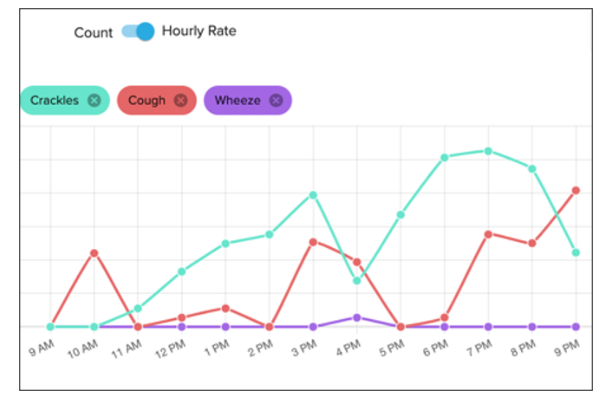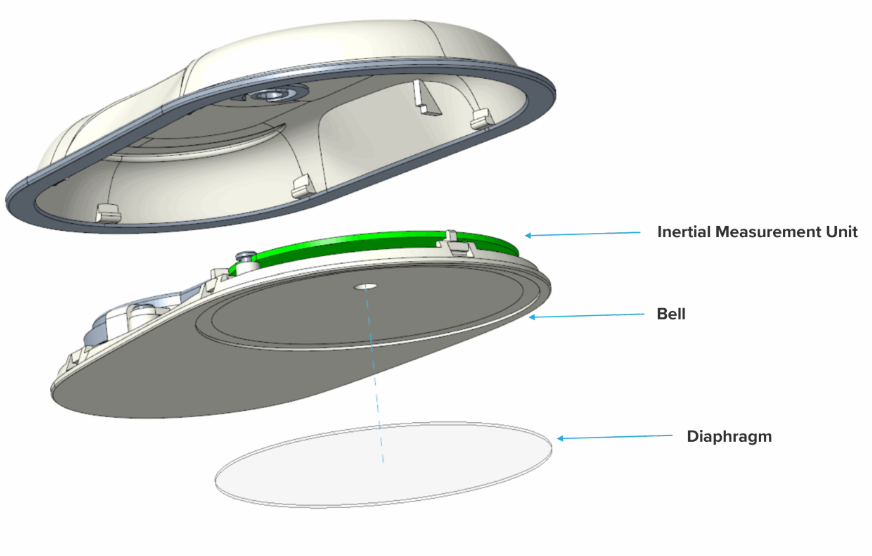The advent of wearable technology is changing how we monitor health across a range of conditions, offering continuous, real-world insights into patients’ vitals and physiological data. At Strados Labs, our goal was to develop a wearable specifically for monitoring patients with chronic respiratory diseases such as COPD and asthma. Our approach? Model our technology after the stethoscope, a trusted tool for assessing lung health for over two centuries. The RESP® Biosensor was designed to capture lung acoustics seamlessly from hospital settings to daily life, building upon the principles of traditional stethoscope auscultation and integrating them into a non-invasive, connected device. This blog explores the core principles behind developing a stethoscope-inspired wearable for collecting lung acoustics.
Adapting Stethoscope Principles into a Wearable
Since its invention over 200 years ago, the stethoscope has been a key tool for monitoring a patient’s respiratory health. It has become so ubiquitous in healthcare that it is often used as a symbol representing doctors, nurses, clinicians, hospitals, and the entire healthcare system. Clinicians are trained to recognize specific sounds and patterns such as wheezing or rhonchi using a traditional stethoscope, which consists of a chest piece, diaphragm (or bell), and tubing that transmits sound to the clinician’s ears. All of these components shape the sound characteristics that the clinician hears. Strados Labs designed the RESP Biosensor to provide sound recordings that closely match the sound heard from a traditional stethoscope, while reducing background noise and motion artifacts, by integrating the following elements:
- Contact-based sensing: Just like a stethoscope’s diaphragm, the wearable sensor makes firm contact with the chest to capture clear sound waves originating from inside the body.
- Acoustic Design: The RESP Biosensor is designed with a stethoscope diaphragm and bell to provide similar sound responses as a traditional stethoscope. The coupling of the sound energy through the diaphragm and bell provides mechanical amplification of the sound of interest coming from the body with the same frequency response as a standard stethoscope. This means of coupling also provides mechanical isolation from ambient sound. Any ambient sound that enters the recording is reduced in volume. Additionally, these ambient sounds will have different frequency characteristics due to their transmission path, making them distinguishable from the internal sounds produced by the patient.
- Digital filtering and amplification: The RESP Biosensor uses advanced signal processing to enhance lung sounds while suppressing irrelevant noise.
Additional considerations in the design of the RESP Biosensor include:
- Continuous monitoring capability: Unlike a stethoscope, which provides only a snapshot in time, the RESP Biosensor can continuously record lung sounds over hours or days similar to how cardiac monitors are designed. Sound files require higher sample rates to achieve adequate fidelity compared to most other physiological measures. This presents significant challenges in terms of file transfer speeds, data processing, memory management, and power management. Strados Labs has addressed these challenges within the design of the processing and transmission architecture of the biosensor allowing for the capture and transmission of all sound data, whereas other technologies often solve these issues by reducing or eliminating data.
- Wireless transmission & AI integration: The RESP Biosensor sends encrypted lung sound, motion, and orientation data to a secure cloud platform for both human and machine learning-powered analysis, offering researchers and clinicians efficient and accurate reporting (machine learning algorithms not FDA cleared).

Image 1: View of lung sounds tracked and trended in the Strados clinician portal

Image 2: Visual spectrograms of lung sounds from the Strados clinician portal
Integrating Additional Sensors for Comprehensive Monitoring
In addition to a MEMS microphone to capture lung sound recordings, we incorporated additional sensors to provide a more holistic view of a patient’s respiratory health. The RESP Biosensor includes an inertial measurement unit (6 degree of freedom gyroscope and accelerometer) to measure movement, orientation, and activity levels, offering key insights into what physical activity, chest wall movement, or posture might reveal about a patient’s respiratory condition (FDA clearance includes lung sounds only). For example, these additional measurements can be used to:
- Correlate lung sounds with movement patterns, identifying activity-induced wheezing or exertion-related cough.
- Monitor patient posture and orientation, which can influence lung function, particularly in conditions like COPD or sleep apnea.
- Measure respiratory rate and monitor chest wall movement to track periods of heavy or shallow breathing.
- Capture vital trends over time, adding further context to lung sound analysis for a comprehensive health assessment.
By integrating multiple sensor modalities, the RESP Biosensor not only enhances lung sound monitoring but also supports a broader, data-driven approach to respiratory care and research.
Designing for Real-World Use
A successful wearable for lung acoustics must consider not just technical feasibility but also patient comfort, usability, and clinical integration. The RESP Biosensor was designed with:
- Lightweight and ergonomic form factor to ensure patient adherence.
- Medical grade adhesives that maintain secure placement without irritation (explore our previous blog on Tegaderm)
- Data analysis and reporting via machine learning and the Strados Labs annotation team to reduce burden on clinicians and researchers.
Conclusion
By grounding the RESP® Biosensor in the trusted tool of the stethoscope and enhancing it with additional measurement capabilities, wireless transmission, and machine learning, Strados Labs has created a powerful tool for advancing respiratory care and research. As we continue to refine our technology, we’re focused on improving our understanding of how lung sounds correlate with traditional clinical measurements and assessments to uncover new insights into respiratory health.
Author

Jason Kroh
Chief Technology Officer
Strados Labs
